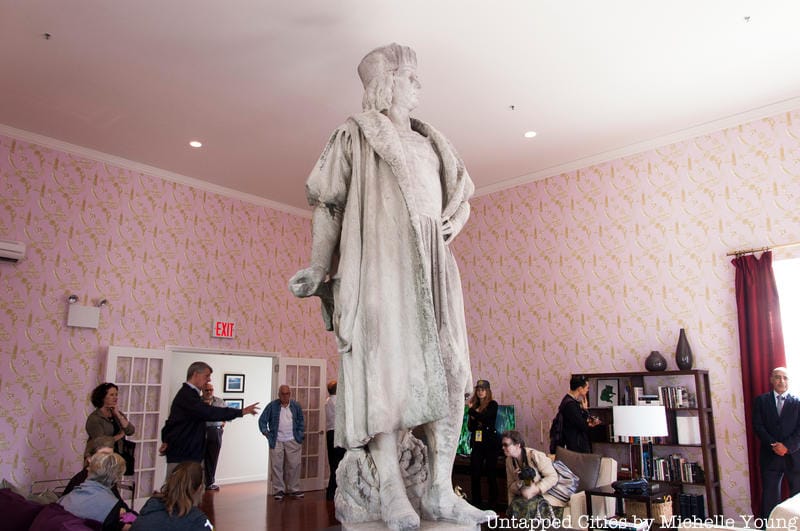How to Make a Subway Map with John Tauranac
Hear from an author and map designer who has been creating maps of the NYC subway, officially and unofficially, for over forty years!


Columbus Circle sits in the southwest corner of Central Park. A 70-foot statue of infamous Italian explorer, Christopher Columbus, stands at its center. Unveiled on October 12, 1892 on the 400th anniversary of Columbus’ voyage to the Americas, the statue was gifted to the city by the Italian-Americans of New York. While Columbus remains a controversial figure in American history, the statue itself still holds many interesting facts.
Columbus Circle got its name from the statue, but the circle itself was part of Frederick Law Olmsted‘s plans for Central Park. Each corner of the park is marked by a unique entrance, and this southwest corner was designed as a turnabout for horse-drawn vehicles. It was referred to simply as “The Circle” or “The Grand Circle” before the monument was installed.
An Italian-language newspaper called Il Progresso launched the campaign to gather funds for a Columbus monument. A wave of small donations from Italian-American businesses came in and the paper raised $20,000. Many Italian-American workers even volunteered their labor to help prepare the land for the monument. The monument was delivered via boat.

For the laying of the statue’s cornerstone in 1892, a procession marched from Little Italy up to Columbus Circle. Close to ten thousand people attended the dedication ceremony. For Italian-Americans who faced discrimination as immigrants in 19th-century New York City, Columbus was a symbol of Italian and American pride.
The statue was sculpted in Italy by Sicilian sculptor Gaetano Russo. The colossal figure of Columbus which stands at the top was carved from Carrara marble while the column is made of granite and the ships which pierce the column are made of bronze. These vessels are Columbs’ famous trio, the Niña, Pinta, and Santa Maria. Additional bronze ornamentation depicting Columbus’ journey and American patriotic symbols adorn the monument, as well as a marble allegorical figure of the Genius of Discovery.
According to the Central Park Conservancy, another Columbus monument was planned for the southeast corner of the park. Though that sculpture was never made, there is a second Columbus statue in the park. The New York Genealogical and Biographical Society commissioned Spanish sculptor Jeronimo Sunol to create a bronze sculpture of the explorer, which now stands at the south and of The Mall.
The Columbus Circle posed as an obstacle for construction of the IRT subway tunnel and Columbus Circle station. Workers had to carefully reinforce the monument’s foundation in order to construct the tunnel and station beneath it. Over the past 130+ years the monument and surrounding circle have seen many changes. Fountains designed by Douglas Leigh and inspired by water displays in Rome were dedicated on Columbus Day, October 12, 1965. The monument was restored in 1992 in commemoration of the 500th anniversary of Columbus’ expedition.

In 2012, artist Tatzu Nishi situated the statue inside a fully furnished living room as part of his Discovering Columbus exhibit. Visitors had to ascend six flights of stairs to reach the fictional space, where they found the statue posing on a coffee table. To add to the authenticity of the experience, Nishi fitted the room with furniture, including tables, chairs, a flat-screen television, and even custom-designed wallpaper.
Today, the Columbus Monument is surrounded by a bustling traffic intersection, a shopping and business district, and pedestrian space. The site also serves as the zero-mile marker of New York City, meaning all distances to New York are measured from there. We’re investigating why this spot was chosen, so if you have any tips, please share them with us at info [at] utappedcities.com!
There are five statues of Columbus across New York City parks in Manhattan, Queens, Brooklyn, and The Bronx. Each site has faced petitions and calls for removal. New York City officials including former Governor Andrew Cuomo and former New York City Mayor Bill de Blasio have supported the statues remaining on view. A report from the Mayoral Advisory Commission on City Art, Monuments, and Markers also recommended keeping the monuments in 2018. As Columbus’ legacy continues to be reexamined, his New York City monuments still stand, for now.
For more, check out The Top 10 Secrets of Columbus Circle in NYC
Originally written by Vera Penavic, with additional reporting by Nicole Saraniero. Updated October 2024.
Subscribe to our newsletter